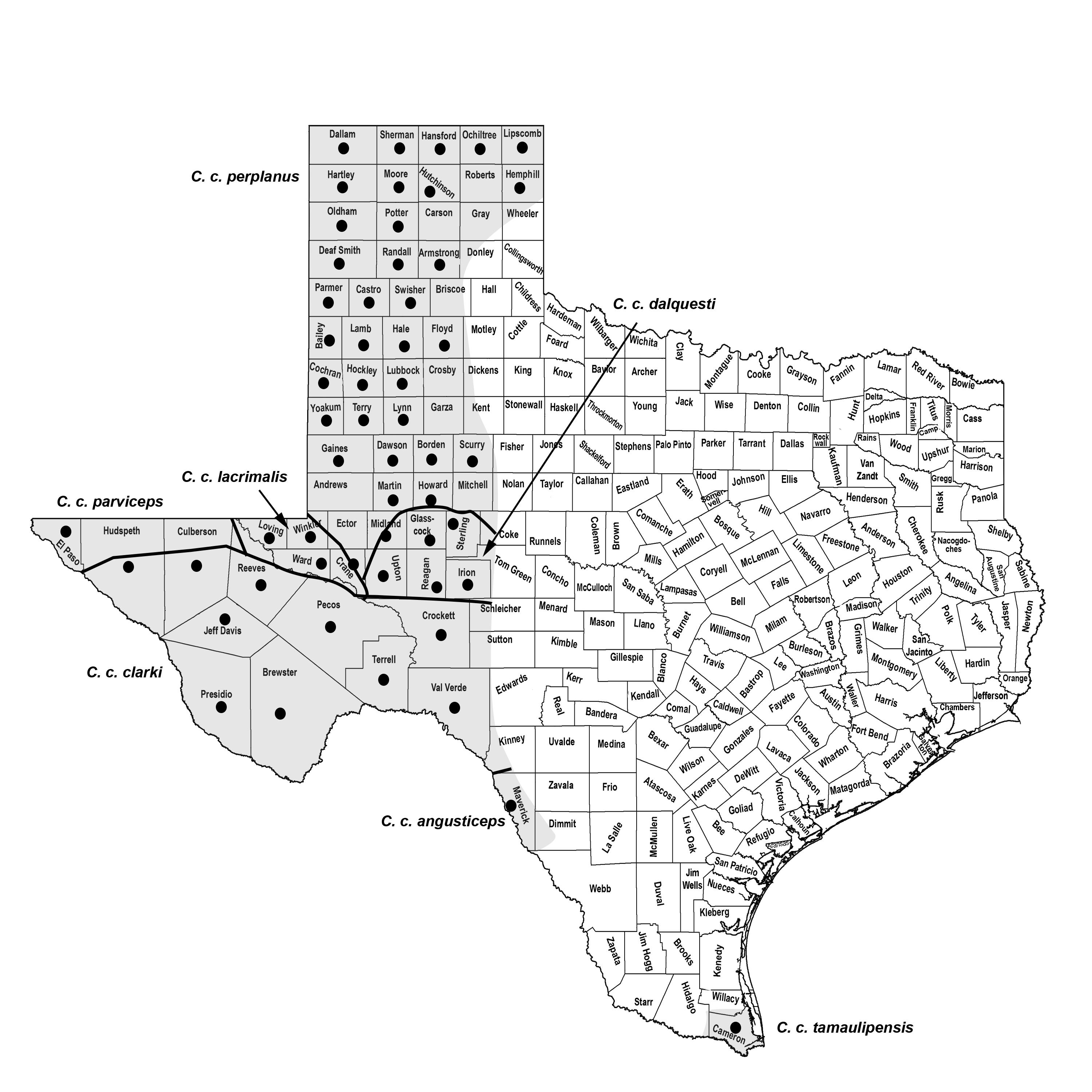YELLOW-FACED POCKET GOPHER
Cratogeomys castanops (Baird 1852)
Order Rodentia : Family Geomyidae
DESCRIPTION. A moderately large pocket gopher, dull yellowish brown in color, with one deep groove on outer face of each upper incisor; feet blackish (whitish in most other gophers). Dental formula: I 1/1, C 0/0, Pm 1/1, M 3/3 × 2 = 20. External measurements averages: males, total length, 295 mm; tail, 95 mm; hind foot, 33 mm; females, 256-77-33 mm. Weight of males, 216–321 g; of females, 213–330 g.

DISTRIBUTION. Found in western one-third of state, from Panhandle southward to the extreme northwestern and western portion of the Edwards Plateau and continuing along the Rio Grande into Maverick and Cameron counties.

SUBSPECIES. Seven subspecies are recognized in Texas: C. c. angusticeps, known only from the vicinity of Eagle Pass, Maverick County; C. c. clarkii in the Big Bend and much of the southern Trans-Pecos area; C. c. dalquesti in west-central Texas to the north of the Edwards Plateau but southeast of the Llano Estacado; C. c. lacrimalis from the New Mexican border south in the Pecos drainage to Reeves, Ward, and Winkler counties; C. c. parviceps in the far western Trans-Pecos; C. c. perplanus on the High Plains of northwestern Texas; and C. c. tamaulipensis, known only from Cameron County.
HABITS. These large-sized gophers are partial to deep, mellow soils that are relatively free from rocks. Where the three genera (Cratogeomys, Geomys, and Thomomys) occur in the same general area, as in western Texas, Thomomys usually occupies the shallower rocky soils in the mountains, Geomys lives in the deep sands along the rivers, and Cratogeomys utilizes the areas in between. However, the sandy areas in which no Geomys occur are likely to be occupied by Cratogeomys. The three genera are usually mutually exclusive in their distribution.
The burrows of Cratogeomys are 75–100 mm in diameter, depending on the texture of the soil. The tunnels and mounds are smaller in clayey than in sandy soils.
These gophers are strictly herbivorous, feeding on plant roots, tubers, bulbs, stems, leaves, and even the outer bark of trees. Alfalfa, clover, hay crops, garden vegetables, and lechuguilla are also utilized.
Cratogeomys castanops is reproductively active throughout the year, with no obvious peaks in activity. Pregnant females have been taken during every month. Litters range in size from one to four, with two being the average number of young. In Lubbock County, females have been found to produce as many as three litters per breeding season, extending from January to October, with a peak period in March and April.
POPULATION STATUS. Common. The yellow-faced pocket gopher is one of the most common pocket gophers throughout its range in Texas.
CONSERVATION STATUS. The IUCN lists the yellow-faced pocket gopher as a species of least concern, and it does not appear on the federal or state lists of concerned species. The two subspecies with highly localized ranges (C. c. angusticeps and C. c. tamaulipensis) should be monitored periodically to ascertain whether they are under threat.
REMARKS. It appears that conditions of increasing aridity may favor the distribution of Cratogeomys over other gophers, such as Thomomys. From early 1969 to April 1970, the Davis Mountains of the Trans-Pecos received little or no rain. As the area became drier, Thomomys bottae, which once occurred from near the bed of Limpia Creek to the foot of the rock bluffs lining the canyon, moved closer to the stream and Cratogeomys castanops moved into the vacated area. These changes may be linked to a decrease in soil moisture and subsequent increase in xeric-adapted plants, both conditions that would favor Cratogeomys over Thomomys. The replacement of T. bottae populations by C. castanops in the Southwest has been noted by several authors during the twentieth century. This phenomenon could be considered as strictly natural, one that normally occurs in the evolution and replacement of species over geological time. The problem, however, is complicated by the overgrazing that has taken place in the Davis Mountains since the 1870s; it changes the environment, causing dramatic plant community changes, increased runoff, and, ultimately, more xeric conditions. The xeric conditions, in turn, favor Cratogeomys over Thomomys.
In situations where Cratogeomys and Geomys are sympatric in the Texas Panhandle, Geomys are restricted to the deep sandy soils, whereas Cratogeomys tend to occupy shallower, firmer soils. Over the last 30 years, Cratogeomys castanops has begun displacing G. knoxjonesi near Brownfield and G. bursarius surrounding Lubbock. It is our opinion that Cratogeomys are using the cherty soils associated with roadbeds to invade habitat normally occupied by Geomys. At both localities, Cratogeomys has led to the local extinction of Geomys populations.
From The Mammals of Texas, Seventh Edition by David J. Schmidly and Robert D. Bradley, copyright © 1994, 2004, 2016. Courtesy of the University of Texas Press.
Natural Science Research Laboratory
-
Address
Museum of Texas Tech University, 3301 4th street, Lubbock, TX 79409 -
Phone
806.742.2486 -
Email
nsrl.museum@ttu.edu

